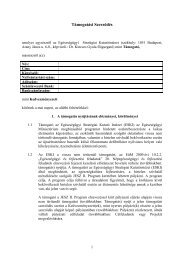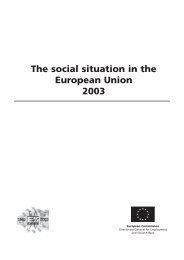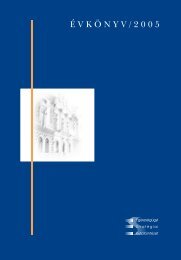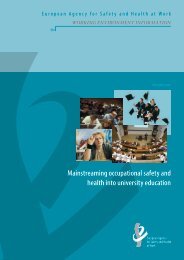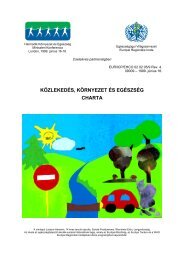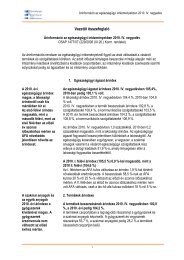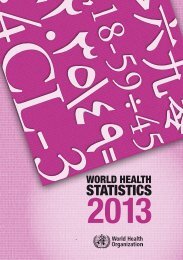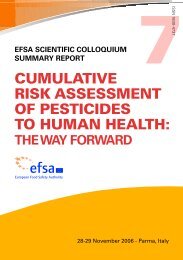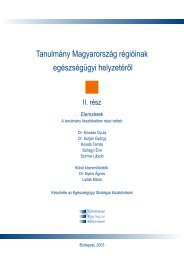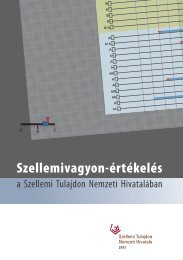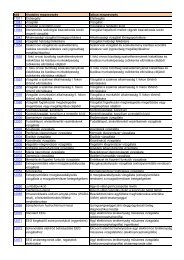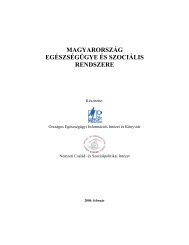Systematic review and evidence- based guidance ... - ECDC - Europa
Systematic review and evidence- based guidance ... - ECDC - Europa
Systematic review and evidence- based guidance ... - ECDC - Europa
You also want an ePaper? Increase the reach of your titles
YUMPU automatically turns print PDFs into web optimized ePapers that Google loves.
<strong>Systematic</strong> <strong>review</strong> <strong>and</strong> <strong>evidence</strong>-<strong>based</strong> <strong>guidance</strong> on perioperative antibiotic prophylaxisTECHNICAL REPORTPAP modalities supported by high- <strong>and</strong> moderate-quality studies were ranked first, followed by those supported bylow-quality studies. Only the 10 modalities ranked highest were retained; lower-ranking modalities were discarded.2.2 Key PAP modalities: indicators <strong>and</strong> barriers toimplementationIn three one-day consensus workshops, an expert group ranked <strong>and</strong> narrowed down the 10 PAP modalities to five.The experts developed a consensus-<strong>based</strong> <strong>guidance</strong> on key modalities <strong>and</strong> defined quality indicators for PAP. Thenames of the expert group members, their institutional affiliations <strong>and</strong> their areas of expertise are provided above;Figure 1 gives an overview of the process.Figure 1. Flowchart: developing five key modalities for PAP<strong>Systematic</strong> <strong>review</strong>:generation of basic key modalitiesFirst expert meeting: <strong>evidence</strong> <strong>and</strong> expert opinion, 10 key modalitiesSecond expert meeting: reduction to 5 key modalitiesThird expert meeting: agreement about appropriate indicators <strong>and</strong> EUwideapplicability for the five selected key modalities2.2.1 First expert meetingThe goal of the first expert meeting in Berlin was to <strong>review</strong> the results of the systematic <strong>review</strong> <strong>and</strong> to <strong>review</strong> theexperts’ scores of the 10 PAP modalities. Prior to the meeting, the experts had received the systematic <strong>review</strong> <strong>and</strong>the results, the 10 PAP modalities <strong>and</strong> an evaluation form, which allowed them to score the 10 PAP modalities onquality of <strong>evidence</strong>, EU-wide applicability <strong>and</strong> implementability. The 10 modalities were then further broken downinto 15 questions or components, so that each item could be clearly described <strong>and</strong> scored individually, thusminimising the risk of misinterpreting the individual components of each PAP modality 4 .2.2.2 Second expert meetingThe second expert meeting was also held in Berlin. The aim was to narrow down the 10 PAP modalities to five byranking them according to quality of <strong>evidence</strong> <strong>and</strong> assessing their EU-wide applicability.Before the second meeting, the experts received a questionnaire with the 10 agreed-upon PAP modalities (Table20) from the first meeting <strong>and</strong> were asked to score them again (Table 21). The submitted scores were thenpresented at the second meeting. Each modality was discussed individually <strong>and</strong> was ranked according to theexperts’ score. Consensus was achieved by unanimous agreement on the five final key PAP modalities.2.2.3 Third expert meetingThe third expert meeting was held in Stockholm. The aim was to develop five quality-of-care indicators for themonitoring of the implementation of the five PAP modalities <strong>and</strong> to identify barriers for EU-wide applicability.Selection of quality indicators4 Further information is available upon request. See p. ii for details.10



